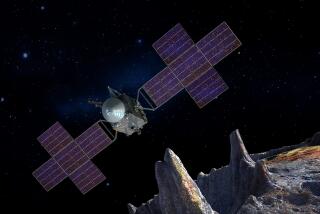A Piece of Us Goes on a Voyage of Wonder
- Share via
Neptune. Almost 3 billion miles from Earth, it’s a cold, impersonal place, a speck of a planet through even the largest telescope, but an enormous gas giant full of mysterious wonders when seen up close.
In a little more than two weeks, we’re going to experience it up close, you and I. We will see it through the eyes of a solar diplomat: a traveler, explorer, adventurer, and representative of the human race; a large metal-plastic-silicon representative named Voyager.
When we arrive, what should we expect? The unexpected. That’s the lesson learned from previous visits to unexplored planets. Are there rings at Neptune like those at Jupiter, Saturn and Uranus? Possibly, but in incomplete arcs, unlike rings anywhere else. Are there other satellites, besides the known Triton and Nereid? Yes! Four others have already been discovered, and there’s tantalizing evidence of more--perhaps many more, maybe even clouds of them--lurking just beneath the fuzz in the images painting the screens of video terminals at the Jet Propulsion Laboratory. In just days, now, they could rise to visibility above the electronic background noise.
Neptune has its own internal heat source, and radiates more energy than it receives from the sun. Why? Is this what drives its turbulent atmosphere, generating the large spots already found? Soon, we may know. And Triton? We’ll find whether it has an atmosphere, and whether we can see through to the surface. Will there be pools of liquid nitrogen, or will gases be frozen in slabs littering a desolate landscape of craters and mountains? Among the answers to the questions we know to ask will be the more questions we’ve not imagined--again, the unexpected.
When Voyager arrives at Neptune on Aug. 24 it will be the first time that anything human-made has been to that planet. We should appreciate and celebrate the event, since it will also likely be the last time it will happen during our lives. That’s because an arrangement of the solar system that occurs only about every 175 years was required to allow Voyager to make the trip in “only” twelve years.
It had to go by Jupiter first, making a hard left turn in that planet’s gravity to pick up energy in a crack-the-whip fashion to go on to the next planet. That was Saturn, which turned it left again, gave it more energy and pointed it towards Uranus. At Uranus, in 1986, it picked up still more energy and made course for Neptune. Since then it has been cruising at 10 miles per second toward Neptune. At Neptune, it will skim over the north pole, 3,000 miles above the atmosphere, turn so that it’s headed south out of the solar system and make a final encounter with Neptune’s largest satellite, Triton, before beginning a larger interstellar voyage.
The science at Neptune is important but think also about the voyage, the adventure. Knowledge is good for the human mind, but travel is food for the psyche. And Voyager’s travels have been and will be prodigious. It has been on its way from Earth since 1977, wending a crooked path through the outer solar system. Now, in a handful of days, it makes its final rendezvous, a close brush and embrace with Neptune, before flying out of the solar system to begin an odyssey through the Milky Way galaxy; an unattended, lonely voyage that may last from millions to billions of years.
Towards the beginning of that longer journey, a mere few hundred thousand years in the future, our sun will have become a faint, uninteresting star in Voyager’s eternally night sky. But no one will be with the spacecraft to appreciate that fact, and our ambassador will be slowly tumbling--sightless, senseless, and alone--in an immensely empty void.
A fellow engineer on our navigation team claims that the spacecraft will actually be on display in the Smithsonian Museums 200 years from now. He thinks that by then we’ll have both the technology and wherewithal to go out, find and catch Voyager, and bring it back. I’d like to think we would be able to do that, but if I’m still around I’ll vote to leave it alone.
There’s something wonderful about the thought that a piece of ourselves is somewhere out there on a winding journey between the stars on its way to eternity. It’s like having immortal children.
There are hazards ahead--for example, unseen ring particles orbiting Neptune could smack into us, prematurely ending Voyager’s life--but we’ll probably make it through to see the wonders of Neptune and Triton. Then will begin the grander voyage--the one that requires us to be romantics instead of realists, dreamers rather than schemers:
Even though Voyager will go blind and deaf after a few tens of years; even though it will die an electronic death, it will still have the germ of human creativity and daring incorporated into its very structure.
It will carry two messages--an explicit one in the form of a golden record, and an implicit one stated by its profoundly improbable existence. And both messages will say to the finder, in essence, “I am from the planet Earth. I am of the human race. We are small and insignificant, but our souls are large because we have set out on a journey to know the universe.”
More to Read
Sign up for The Wild
We’ll help you find the best places to hike, bike and run, as well as the perfect silent spots for meditation and yoga.
You may occasionally receive promotional content from the Los Angeles Times.






